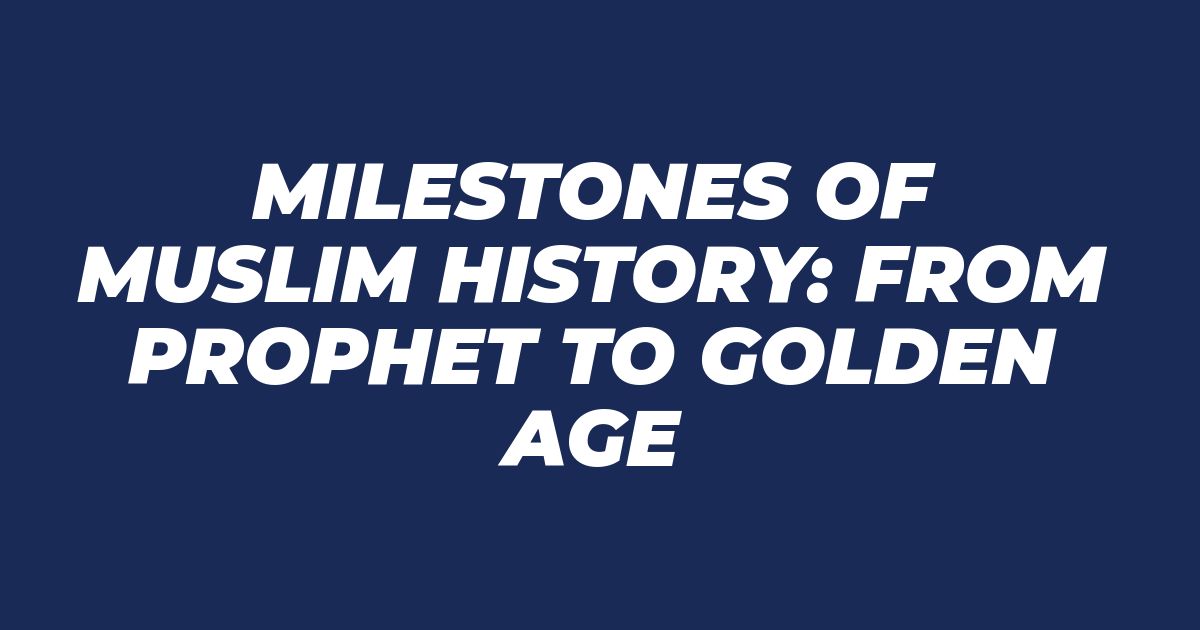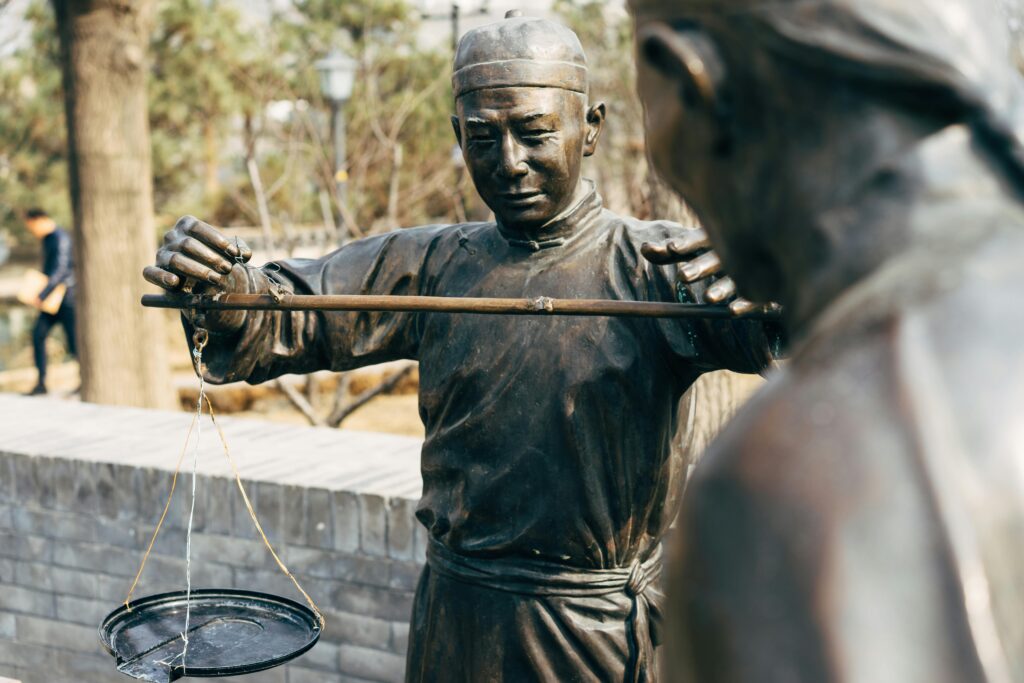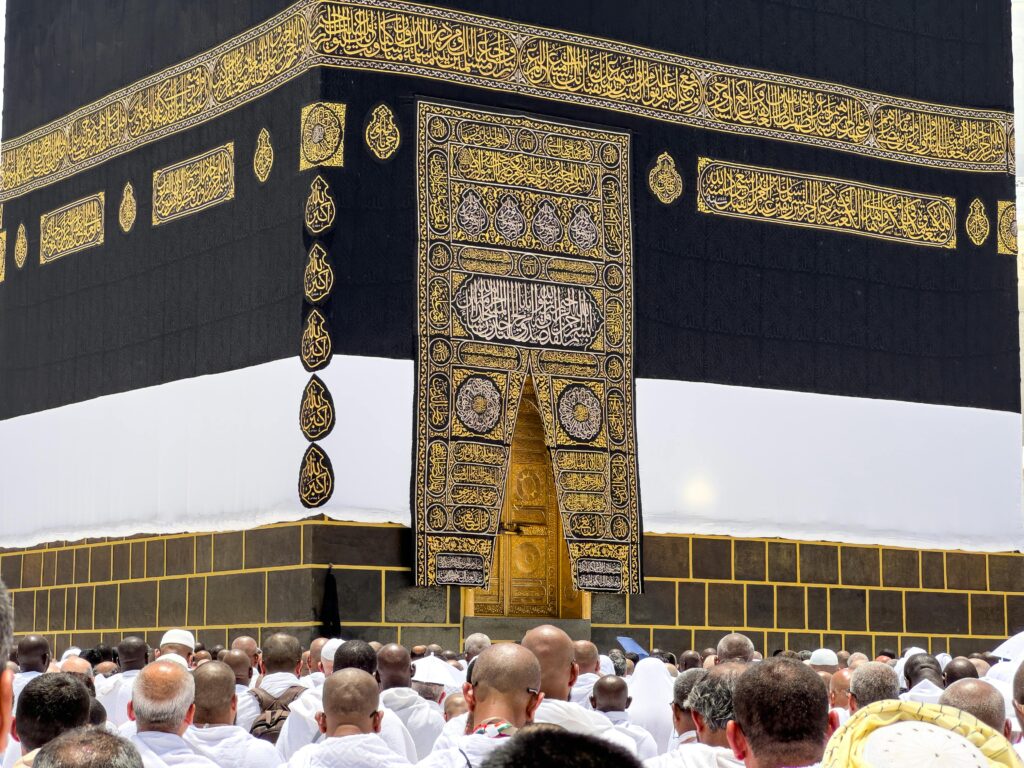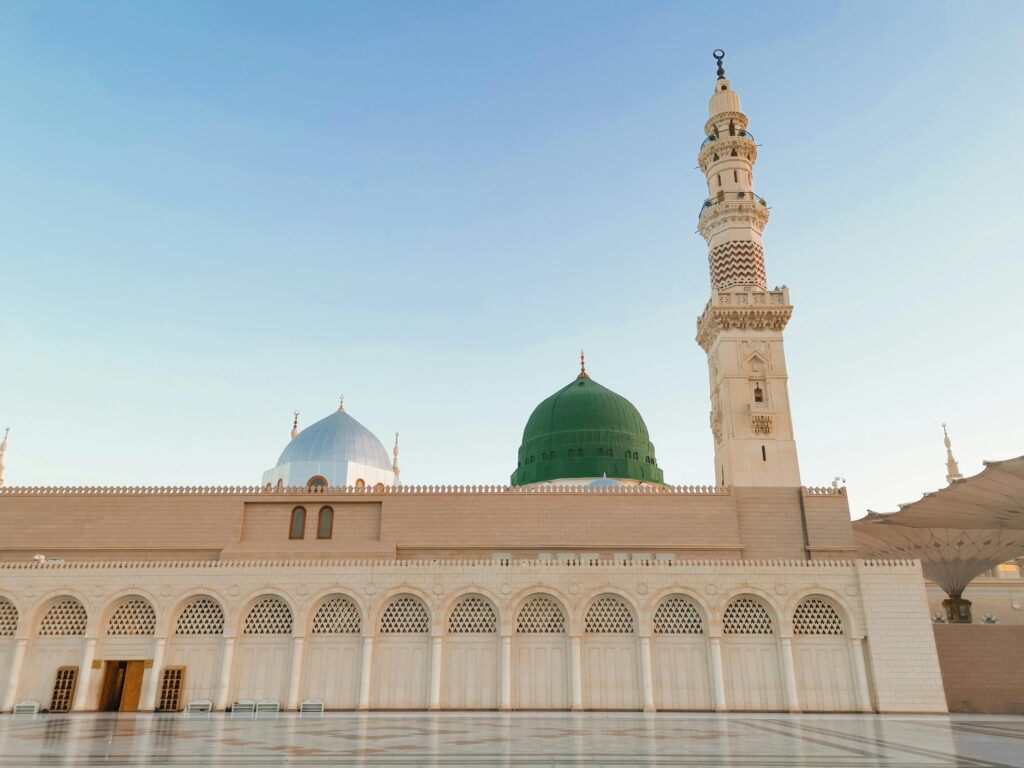Muslim History Timeline (Key Events and Leaders from 600 to Today)
Muslim history shapes cultures, politics, and societies worldwide. Starting with the birth of Islam in 610 CE, this timeline highlights the key events and leaders that influenced its growth and impact. From the Prophet Muhammad’s mission to the rise of major empires like the Umayyads, Abbasids, and Ottomans, you’ll get a clear look at the milestones that define Muslim history. This overview aims to offer a straightforward guide to the moments and figures that have shaped the Muslim world from its beginnings to today.
For more context and visual aid, check out this video that covers the extensive history in a concise way: https://www.youtube.com/watch?v=MpcgXTnd_74
The Birth of Islam and the Prophet Muhammad
The beginning of Islam revolves around the life and mission of the Prophet Muhammad, whose teachings reshaped the Arabian Peninsula and beyond. Born around 570 CE in Mecca, Muhammad belonged to the Quraysh tribe, a powerful merchant family. At 40, his life changed dramatically when he received a series of divine revelations. These were the roots of a new faith that highlighted monotheism and brought a fresh perspective on morality, justice, and social unity.
Early Revelations and Teachings
Muhammad’s first revelations came in 610 CE while meditating in the cave of Hira, near Mecca. The message was clear: there is only one God, Allah, and people should live with honesty, compassion, and fairness. This idea of monotheism stood in direct contrast to the polytheistic practices common in Arabia at that time.
His teachings called for social justice, urging care for the poor, orphans, and widows. He also emphasized unity within the community, urging people to look beyond tribal rivalries. These early messages faced strong resistance from Meccan leaders who saw his growing following as a threat to their social and economic order.
Despite opposition, Muhammad’s courage in spreading his message inspired a devoted group of followers who believed in the promise of equality and a moral revival. He consistently preached peace, respect, and dedication to one God, which distinguished Islam’s foundation source.
Hijra and Establishment of the Muslim Community
In 622 CE, facing increasing persecution, Muhammad and his followers undertook the Hijra—a migration from Mecca to Yathrib, later called Medina. This journey was more than a physical escape; it symbolized the birth of the Muslim community and the start of the Islamic calendar.
In Medina, Muhammad became not only a spiritual leader but also a political and social one. He united the city’s diverse tribes under Islam through the Constitution of Medina, a pioneering document that outlined rights, duties, and mutual protections for Muslims, Jews, and other groups. This constitution established a pluralistic society with shared governance and respect for diversity.
This pivotal move to Medina allowed Islam to grow openly and organized. It became a blueprint for religious tolerance and governance that shaped Muslim identity for centuries to come. Muhammad’s role expanded beyond prophecy into leadership and state-building source.

Photo by Sami TÜRK
Key Battles and Consolidation of Islam
The rise of Islam also involved several key battles that solidified Muslim power in Arabia. The first major conflict was the Battle of Badr (624 CE), where Muhammad’s smaller force defeated the much larger Quraysh army of Mecca. This victory boosted the morale of the Muslims and demonstrated that their faith had real political and military strength.
The next significant clash was the Battle of Uhud (625 CE), which was more challenging for Muhammad’s forces. Though not a defeat, it was a lesson in unity, resilience, and strategy.
Finally, the conquest of Mecca in 630 CE marked the culmination of Muhammad’s leadership. Rather than seek revenge, Muhammad entered Mecca peacefully, granting amnesty to many former enemies. This approach helped unite Arabia under Islam and transformed Mecca into the religion’s spiritual center.
Through these battles and his leadership, Muhammad secured Islam’s dominance in the region and laid the foundation for its spread far beyond Arabia. His religious and political legacy shaped a community grounded in faith, justice, and unity source.
These events, from revelations in a cave to the peaceful conquest of Mecca, tell the story of how Islam began and grew under the determined leadership of the Prophet Muhammad.
The Rashidun, Umayyad, and Abbasid Caliphates: Expansion and Golden Age
The first few centuries after Prophet Muhammad’s passing marked a period of rapid growth and profound change. The leadership of the early caliphs guided the expansion of territories and the birth of Islamic governance. Following them, the Umayyad and Abbasid caliphates shaped political structures, culture, and knowledge in ways that still influence the world today. Let’s look closely at these three key caliphates and their contributions.
Rashidun Caliphate (632-661 CE)
The Rashidun Caliphate began right after Prophet Muhammad’s death, led by four remarkable leaders: Abu Bakr, Umar, Uthman, and Ali. These caliphs carefully balanced spiritual guidance and practical governance, securing the unity of an expanding Muslim community.
During this time, Islamic rule extended far beyond Arabia. The caliphs led military campaigns that quickly brought the Levant, Egypt, parts of Persia, and North Africa under their control. Their approach wasn’t just about conquest; it focused on steady administration and respect for local customs and populations, helping build a strong yet flexible system.
The Rashidun era introduced key ideas that would guide the Islamic world, including governance based on consultation and justice, protection of religious minorities, and solidifying early Islamic law. Their leadership helped turn a fledgling community into a recognized state with an expanding influence. For a detailed description of this formative period, Britannica offers a clear summary of the Rashidun Caliphate’s history and significance.
Umayyad Caliphate (661-750 CE)
The Umayyad Caliphate marked a shift toward a more centralized and formal governmental structure, with its capital in Damascus. Under their rule, the empire stretched widely—from Spain’s Iberian Peninsula in the west to the edges of India in the east.
This was a period of grand territorial expansions. The Umayyads established Muslim rule in Spain, creating al-Andalus, which became a vibrant cultural hotspot mixing Arab, Berber, Christian, and Jewish influences. Meanwhile, their reach toward India expanded trade and cultural contacts, linking diverse peoples.
Alongside growth came challenges. The Umayyad rulers faced internal dissent and pressure from non-Arab Muslims demanding more inclusion. Despite this, they built efficient tax systems, developed a bureaucracy, and fostered arts and architecture that reflected their complex identity. The Umayyad period laid the groundwork for later Islamic empires. For a solid overview, Britannica provides insights into their achievements and political structure.
Abbasid Caliphate and the Islamic Golden Age (750-1258 CE)
Taking power from the Umayyads, the Abbasids moved the capital to Baghdad, a city that soon grew into the intellectual heartbeat of the Muslim world. This era, known as the Islamic Golden Age, bloomed with scientific, cultural, and legal advances.
Baghdad attracted scholars from far and wide. They worked in famous libraries and institutions, translating important texts from Greek, Persian, and Indian sources into Arabic. This mixing pot of knowledge sparked innovations in astronomy, mathematics (like algebra), medicine, and philosophy.
One of the most famous Abbasid leaders, Harun al-Rashid, championed this age of learning and arts. The Abbasids also helped establish the major Sunni schools of Islamic law, organizing religious and social life with clearer legal systems.
The era redefined what a society centered on knowledge could look like—urban centers thrived, public education expanded, and cultural achievements set standards for centuries. Britannica has comprehensive articles on the Abbasids and their Golden Age, detailing this crucial period’s contributions.
Through these three caliphates, Muslim governance and culture evolved from a small community to a vast empire, blending administration with a deep love for learning and justice.
For more in-depth reading, check out Britannica’s entries on the Caliphate, Umayyad dynasty, and Abbasid caliphate.

Photo by Babar Nawaz
Regional Empires, Cultural Exchange, and Historical Challenges
As the Muslim world expanded, various empires rose that shaped the cultural and political map in lasting ways. These regional powers not only controlled vast territories but also fostered rich exchanges of ideas, arts, and sciences. They faced ongoing challenges, both internal and external, which tested their resilience. Let’s explore some of the most influential dynasties and key events that illustrate these dynamics.
Fatimid and Other Regional Dynasties
The Fatimids made a bold entrance into Muslim history by establishing an empire that challenged the Abbasid Caliphate. In 969 CE, they conquered Egypt under the leadership of General Jawhar. Shortly after, they founded the city of Cairo (al-Qahirah) in 973 CE, which became their political and cultural capital. Cairo was built strategically near the Nile and quickly grew into a thriving center of Islamic learning and power.
The Fatimids claimed a special religious status as descendants of Fatimah, the daughter of the Prophet Muhammad. This gave their rulers a unique claim to Islamic leadership, setting them apart from the Sunni Abbasids in Baghdad. Their reign introduced distinct Shia traditions and promoted belt-tightening cultural developments that broadened Islamic art and architecture.
Though their empire stretched across North Africa and parts of the Middle East, their control was often challenged by rival Muslim states and Crusaders. Still, the Fatimid dynasty left a lasting legacy, especially through Cairo, which remains a vital historical and cultural hub today. For a deeper dive into their impact, Britannica offers detailed insights on the Fatimid dynasty.
The Ottoman Empire and Islamic Dominance
The rise of the Ottoman Empire marked a turning point, shifting Muslim political power to Anatolia and Southeast Europe. Founded in the late 13th century as a small Turkish principality, the Ottomans rapidly expanded their control under visionary leaders. The pinnacle of their early success was the conquest of Constantinople in 1453 CE by Sultan Mehmed II.
This event effectively ended the Byzantine Empire and established Istanbul (formerly Constantinople) as the new Ottoman capital. The Ottoman Empire became not only a vast political power but also a central religious authority, with the sultans claiming the title of Caliph to lead the Sunni Muslim world.
For nearly 500 years, the Ottomans controlled key trade routes and cultural crossroads spanning Europe, Asia, and Africa. Their empire was known for blending diverse populations while maintaining Islamic law and traditions. Despite facing internal struggles and external pressures, the empire lasted until the early 20th century, shaping the modern Middle East and Southeastern Europe. To explore their history further, Britannica provides comprehensive coverage of the Ottoman Empire.
The Crusades and Religious Conflicts
Religious conflict between Muslims and Christians escalated dramatically with the Crusades, a series of military campaigns aiming to capture the Holy Land. The First Crusade began in the late 11th century, culminating in the capture of Jerusalem by Christian forces in 1099 CE. This event had a profound impact on Muslim-Christian relations for centuries.
Jerusalem remained a focal point of tension. The Crusader states, established after 1099, disrupted Muslim control over the region until the famous Muslim leader Saladin recaptured the city in 1187 CE. These wars caused widespread suffering but also fostered cultural exchanges, including the transfer of knowledge, trade goods, and scientific ideas between East and West.
The Crusades influenced both sides’ military and political strategies and left a legacy of mistrust that echoes in historical memory. For a thorough overview of these events, you can reference the detailed history on the Crusades from Britannica.
Together, these regional empires and conflicts shaped the Muslim world’s growth, tested its resilience, and enriched its cultural heritage.
Modern Era: Colonialism, Nationalism, and Contemporary Leaders
The modern era brought radical changes to the Muslim world. Old empires collapsed, borders were redrawn, and new nations emerged from the shadows of colonial rule. The effects of European colonialism reshaped political power, society, and identity across Muslim lands, while nationalist movements and modern leaders influenced the direction of Islamic politics and culture in the 20th century and beyond. This section explores the crucial turning points from the fall of the Ottoman Empire through contemporary Muslim communities worldwide.
Impact of Colonialism and the Fall of the Ottoman Empire
World War I marked the beginning of the end for the Ottoman Empire, which had ruled much of the Muslim world for centuries. Defeated by Allied forces, the empire was dismantled, and its vast territories were divided under European mandates. Britain and France gained control over large parts of the Middle East, including Palestine, Syria, Iraq, and Lebanon, reshaping political boundaries without regard to ethnic, religious, or cultural realities.
This shift surprised many and deeply altered power dynamics. The idea of the Islamic Caliphate, once symbolized by the Ottomans, faded, replaced by Western-style nation-states. Colonial authority imposed new legal systems, education, and economic policies, often disrupting established Muslim institutions. The mandates created tensions and fostered nationalist movements as local populations sought autonomy and self-rule.
European colonialism left a legacy of division in these regions, alongside the introduction of secular governance models. This era planted the seeds of conflicts that persist today. The scramble for resources and control also silenced many Muslim voices, pushing leaders and people to debate how to maintain their identity under foreign rule. For a fuller history on colonialism’s impact during this period, see this resource on European colonialism and Muslim territories.
20th Century Movements and Leaders
The 20th century saw dramatic events and influential figures that reshaped Muslim political and religious life. One key development was the rise of the Nation of Islam in the US, a movement mixing religious identity and civil rights activism that demanded dignity and justice for African Americans.
The creation of the state of Israel in 1948 brought major upheaval in the Middle East. Israel’s declaration of independence was recognized by many Western powers, leading to decades of conflict and displacement for Palestinians. This event has remained central to regional politics and Islamic activism.
In 1979, the Iranian Revolution shook the Muslim world by overthrowing the Western-backed Shah and establishing an Islamic Republic under Ayatollah Khomeini. This revolution combined religious authority with political power, inspiring Islamist movements across many countries.
Other significant figures shaped modern Islamic thought, such as Hasan al-Banna, founder of the Muslim Brotherhood, a key player in political Islam. These leaders faced the challenge of answering how Islam fits into the modern nation-state, democracy, and global geopolitics. Their efforts sparked debates that continue today over religion’s role in governance and society.
The Iranian Revolution and related events drew attention worldwide, as detailed in this summary on the Iranian Revolution. For more on Israel’s establishment and its impact, this comprehensive article on Israel’s founding is a useful reference.
Muslim Communities in the Modern World
Migration patterns in the 20th and 21st centuries have led to growing Muslim populations in the West, creating new dynamics and cultural diversity within global Islam. Many Muslims moved for economic opportunities, education, or refuge from conflict, settling in Europe, North America, and beyond.
These communities reflect a broad range of ethnicities, interpretations, and experiences. Today’s Muslim identity in the West is not singular but a mosaic of traditions and modern realities. This diversity includes Sunni and Shia sects, cultural customs from Asia, Africa, the Middle East, and interpreters of Islam in entirely new social settings.
Muslim immigrants often balance maintaining their faith and traditions with integrating, leading to unique expressions of religious life, community building, and political activism. Issues like Islamophobia, religious freedom, and identity politics shape their experiences.
This global dispersal highlights how Islam continues to adapt and thrive, while also facing challenges that call for thoughtful responses from both Muslims and broader societies.

Photo by Doğan Alpaslan Demir
The transformation during the modern era reflects how history’s sweeping forces—colonialism, nationalism, and the emergence of new leaders—have continuously shaped Muslim societies. Each chapter in this period builds on the past, setting the stage for new challenges and opportunities in the global Muslim world today.
Conclusion
Muslim history spans a vast timeline, from the Prophet Muhammad’s first revelations to the rise of empires like the Rashidun, Umayyad, Abbasid, Fatimid, and Ottoman. Each era brought key leaders and events that shaped religious, political, and cultural landscapes across regions from the Arabian Peninsula to Europe, Africa, and Asia.
This rich history highlights the growth of Islam as a faith and a civilization, influencing global culture, law, science, and governance. The challenges and achievements of past leaders continue to offer lessons for today’s diverse Muslim communities worldwide.
Understanding these milestones helps us appreciate Islam’s deep historical roots and ongoing role in shaping societies. Keep exploring this timeline to connect past legacies with the present and future of the Muslim world. Thank you for reading, and feel free to share your thoughts or questions below.




